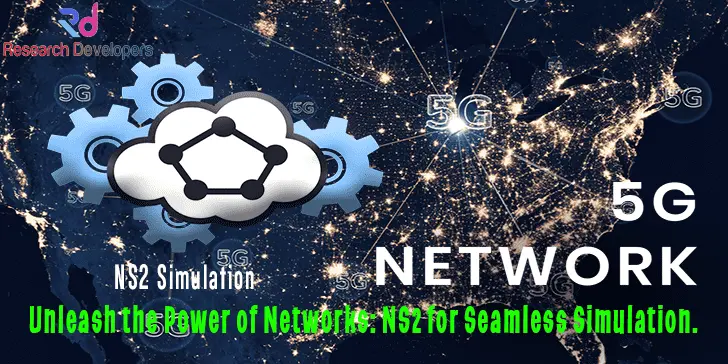NS2 Implementation
Where research begins: Expert guidance on topic selection.

NS2 Implementation
A modelling technique utilized for simulating networks, for instance VANETs and MANETs, is known as network simulation (NS). Whether your network is wired or wireless, this programme can simulate multicast and mapping protocols. Network Server (NS), more often known as NS2, is licenced for use under the General Public Licence (GPL) version 2. A discrete event-driven simulator written in Otcl/Tcl and C++ is at issue here.
Aside from controlling the behaviour of traffic sources including FTP, Telnet, Web, CBR, and VBR, NS-2 can execute network protocols like TCP and UDP. It has a number of useful features, including the ability to use routing algorithms and manage router queues using techniques such as Drop Tail, RED, and CBQ. While Otcl is used for setup, C++ is used for thorough protocol implementation in ns2. To provide control of pre-existing C++ objects at the OTcl level, the compiled objects are supplied to the Otcl interpreter.
NS2 provides simulations that are animated as well as text-based. Two results are produced by the object-oriented language when it is executed. An output file called a.tr, which records the results of the text-based simulation, is the first item to be produced. An a.nam file, useful for animation-based simulation, is the second output. As part of your NS2 thesis, you will learn how to use the xgraph tool to create line graphs from trace files. By examining these graphs, one can examine the network’s performance according to parameters like latency, bandwidth utilisation, and throughput. The goal of developing C++ scripts is to analyse the performance of the network. Numerical results for measures like throughput, latency, and bandwidth consumption are produced by using the main trace file as input. Because no other simulator offers both text-based and animation-based simulations, the NS2 simulator sees heavy usage.
There are two main components to the NS2 framework: the simulation engine and the C++ component. The former is responsible for implementing the Otcl component and the latter provides the user interface and user-C++ interaction. Coordination and execution of events, maintenance of the network state, and handling of complicated tasks like packet processing and bit-level manipulation are all responsibilities of the C++ section. The Otcl component is responsible for specifying the network scenario, creating and configuring nodes and links, and other network aspects.
Simulation refers to the experiential learning process. Whenever novel information emerges, our initial approach is to scrutinise it, thereby acquiring a wealth of knowledge. The course in question is titled “Simulation.”
In order to comprehend the intricacies involved in modelling the complete role-play through computer simulation, it is necessary to construct artificial objects and give them roles in a dynamic manner.
Computer simulation is the act of using a digital computer to create a theoretical physical system. It mostly involves designing, analysing, and executing the model. Once the mathematical model has been developed, the subsequent crucial task involves the design of a computer programme that facilitates the updating of state and event variables throughout time, employing techniques such as time slicing or event scheduling. Parallel or Distributed simulation refers to the execution of this simulation in a sequential manner on parallel machines.
In order to utilise NS2, it is vital to possess a fundamental comprehension of both C++ and Otcl. In order to compose a simulation script, it is necessary to utilise both languages simultaneously. In the Otcl programming language, the network architecture and scenario are defined, while the code for the protocol implementation is written in C++.
Some of the features of NS2 are:
1. It can simulate both wireless and wired network.
2. It provides support to protocols like UDP, FTP, TCP, HTTP.
3. It is a Unix-based, discrete event simulator.
4. It uses the C++ programming language for functioning.
5. There are contributions from third parties.
We specialize in supporting scholars with NS2, a powerful tool for multipath routing and real-time protocol simulations. Our expertise lies in data analysis and software simulation, contributing to successful research and implementation endeavors. Running a simulation in ns-2 only from C++ is not feasible. Furthermore, certain elements of ns-2 are implemented using C++, while others are implemented using OTcl.
Several prevalent study subjects that employ NS2 include:
1. Ad hoc networks
2. Wireless sensor networks
3. Quality of Service (QoS) in networks
4. Internet of Things (IoT)
5. Routing protocols
Other Services
-
PHD & POST DOC Admission counselling
-
Topic Section
-
Review Paper Writing
-
Systematic Literature Review (SLR)
-
Research Paper Writing
-
Synopsis Writing/Pre thesis writing
-
Thesis Writing
-
Data Analysis
-
Questionnaire Preparation
-
Developing Research Framework
-
Methodology Development
-
MATLAB Implementation
-
Matlab Simulation
-
Python Implementation
-
Machine Learning Implementation
-
Deep Learning Implementation
-
VHDL Implementation
-
Hadoop
-
NS2 Implementation
-
NS3 Implementation
-
ArcGis Mapping & Analysis
-
Spss Data Analysis
-
Stata Data Analysis
-
Amos Analysis
-
R Programming
-
E-Views Data Analysis
-
Minitab Data Analysis
-
Software Testing
-
Ansys Implementation